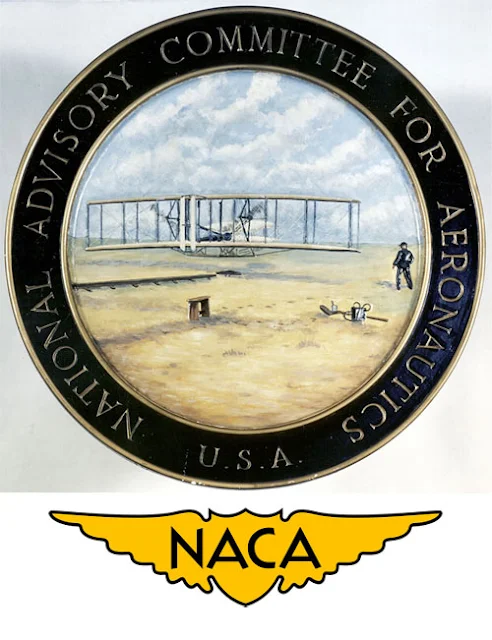National Advisory Committee for Aeronautics (NACA)
National Advisory Committee for Aeronautics or NACA was founded on 1915. Its main purpose was to do pioneering research on the field of Aeronautics to improve the quality and the quantity of flight and also to regulate the academic and technological work on Flight Related Issues. As NACA got off a start, its purpose would also become to regulate the budgeting, to regulate, and govern the policy for aeronautical research and flight.
When NACA was founded in 1915, it was allotted a budget of $5000 per year. This budget would stay constant for 5 years and then it was to show a dramatic increase in the 1920’s as research got off to a big start. When it was first founded, NACA was to be regulated by a committee of 12 people who would not get paid for their work.
 |
| The official seal of NACA, depicting the Wright brothers' first flight at Kitty Hawk, North Carolina |
They would be drafted from the War Department, from the NAVY, from the Weather Bureau and from the Bureau of Standards along with other prominent members of the Aeronautical community. It was perhaps this spirit that arose from doing un paid but pioneering work that made NACA and consequently the United States a leader in aeronautics and aerospace which it still enjoys as a country even today with unparalleled and unmatched success.
Although the role of NACA and its executive committee was advisory only, it was destined for NACA to gain control of the aeronautical sector and be more than an advisory committee but become a fully functional and powerful executive government agency. Thus, it was destined to become NASA, which has turned into the world’s most powerful aerospace research and policy agency.
The first employee was hired in 1915. However, the first executive director would not be appointed until 1919 when George W. Lewis would become the first director of NACA. He would be mainly staying in Washington for politics while the rest of NACA scientific staff prospered and focused on pure and practical research.
The facilities of NACA were founded in Langley, Virginia as the first real aeronautical wind tunnel was constructed there. The facility soon became the Langley Memorial Aeronautical Laboratory which would be intact with a fully equipped aeronautical wind tunnel for testing wing performance and their aerodynamics, propulsion laboratory for testing various engines and an airstrip to test run the various apparatus and planes there.
NACA attracted all kinds of brilliant and successful engineers from all over the country. It was a sign of prestige to work at NACA and many mechanical and electrical engineers were recruited. In time as Aeronautical Engineers became more found, there would be an influx of Aeronautical Engineers to Langley facility. However, the main task force never exceeded 100 people for a long time. This was perhaps the reason for the success of the NACA to be the leading edge of technology at the time.
As the staff was less, the relationship between the senior members of the staff and the junior members of the staff were very strong and informal. This caused a free flow of exchange of ideas, which resulted in technological breakthroughs. It was very common for senior and junior engineers and other staff members to exchange ideas over lunch or over a cup of coffee. In fact, as long as nothing sensational was done, everyone was free to pursue their ideals and their research as they saw fit.
Although at the time only NACA enjoyed such freedom in a Government Agency, with the Era at the time, it proved to be the right thing to do as NACA prospered and the lead in flights research was to be the Americans until today from that day forward. Especially at the Wartime, the policies of NACA were responsible for the superior power in Air Force that United States still enjoys today. When NACA was dismantled in 1958 to become NASA; it had become a very powerful and capable agency that was also responsible for the success of NASA in Space Flight that it still enjoys today.
Read also: The Earliest Airports
Read also: The Earliest Airports